Source: Network
Communication between electronic devices is like communication between humans; both parties need to speak the same language. In electronic products, these languages are called communication protocols.
I previously shared articles on SPI, UART, and I2C communication separately, and this article compares them.
Serial VS Parallel
Electronic devices communicate by sending data bits back and forth. A bit is binary and can only be 1 or 0. Bits are transmitted from one device to another through rapid changes in voltage. In a 5V system, “0” is communicated through a short pulse of 0V, while “1” is communicated through a short pulse of 5V.
Data bits can be transmitted in parallel or serial form. In parallel communication, data bits are transmitted simultaneously along multiple wires. The image below shows the parallel transmission of the letter “C” in binary (01000011):
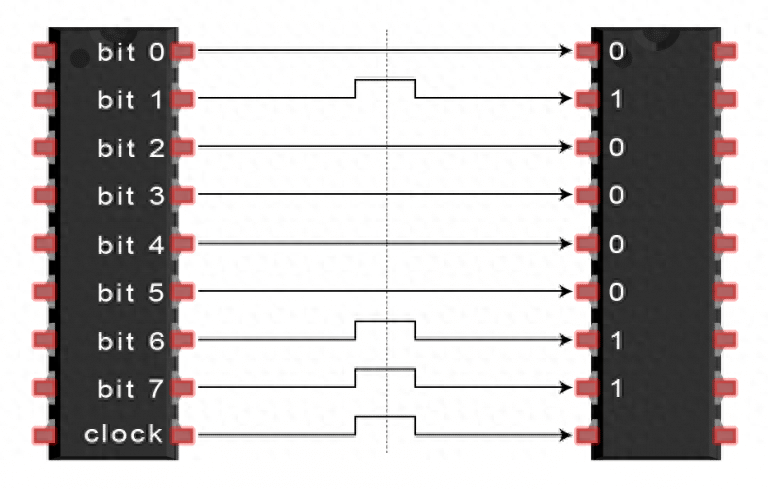
In serial communication, bits are sent one by one along a single wire. The image below shows the serial transmission of the letter “C” in binary (01000011):

SPI Communication
SPI is a common general-purpose communication protocol. Its unique advantage is that it allows uninterrupted data transmission, enabling continuous sending or receiving of any number of bits. In contrast, I2C and UART send data in packets, limiting the number of bits.
In SPI devices, devices are categorized into master and slave systems. The master controls the device (usually a microcontroller), while the slave (usually a sensor, display, or memory chip) receives instructions from the master.
One set of SPI communication consists of four signal lines:MOSI (Master Output/Slave Input) – signal line, master outputs, slave inputs. MISO (Master Input/Slave Output) – signal line, master inputs, slave outputs. SCLK (Clock) – clock signal. SS/CS (Slave Select/Chip Select) – chip select signal.
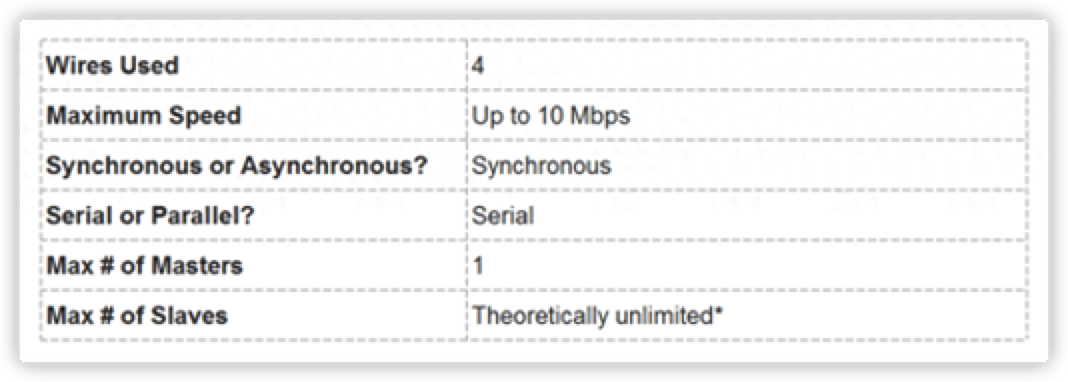
Characteristics of the SPI Protocol
In fact, the number of slaves is limited by the system’s load capacitance, which can reduce the master’s ability to switch accurately between voltage levels.
Operating Principle
Clock Signal
Data is transmitted one bit per clock cycle; therefore, the speed of data transmission depends on the frequency of the clock signal. The clock signal is generated by the master, so SPI communication is always initiated by the master.
Any communication protocol that shares a clock signal is called synchronous. SPI is a synchronous communication protocol, while some asynchronous communications do not use a clock signal. For example, in UART communication, both parties are set to a pre-configured baud rate, which determines the speed and timing of data transmission.
Chip Select Signal
The master enables communication by pulling the slave’s CS/SS low. In idle/non-transmission state, the chip select line remains high. There can be multiple CS/SS pins on the master, allowing communication with multiple different slaves.
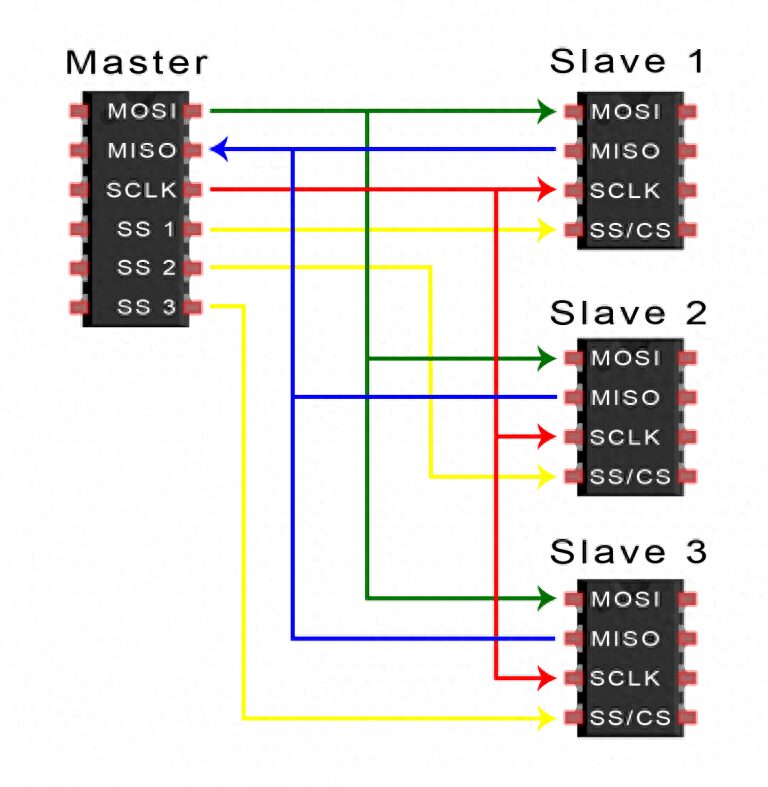
If the master has only one chip select pin available, slaves can be connected in the following manner:
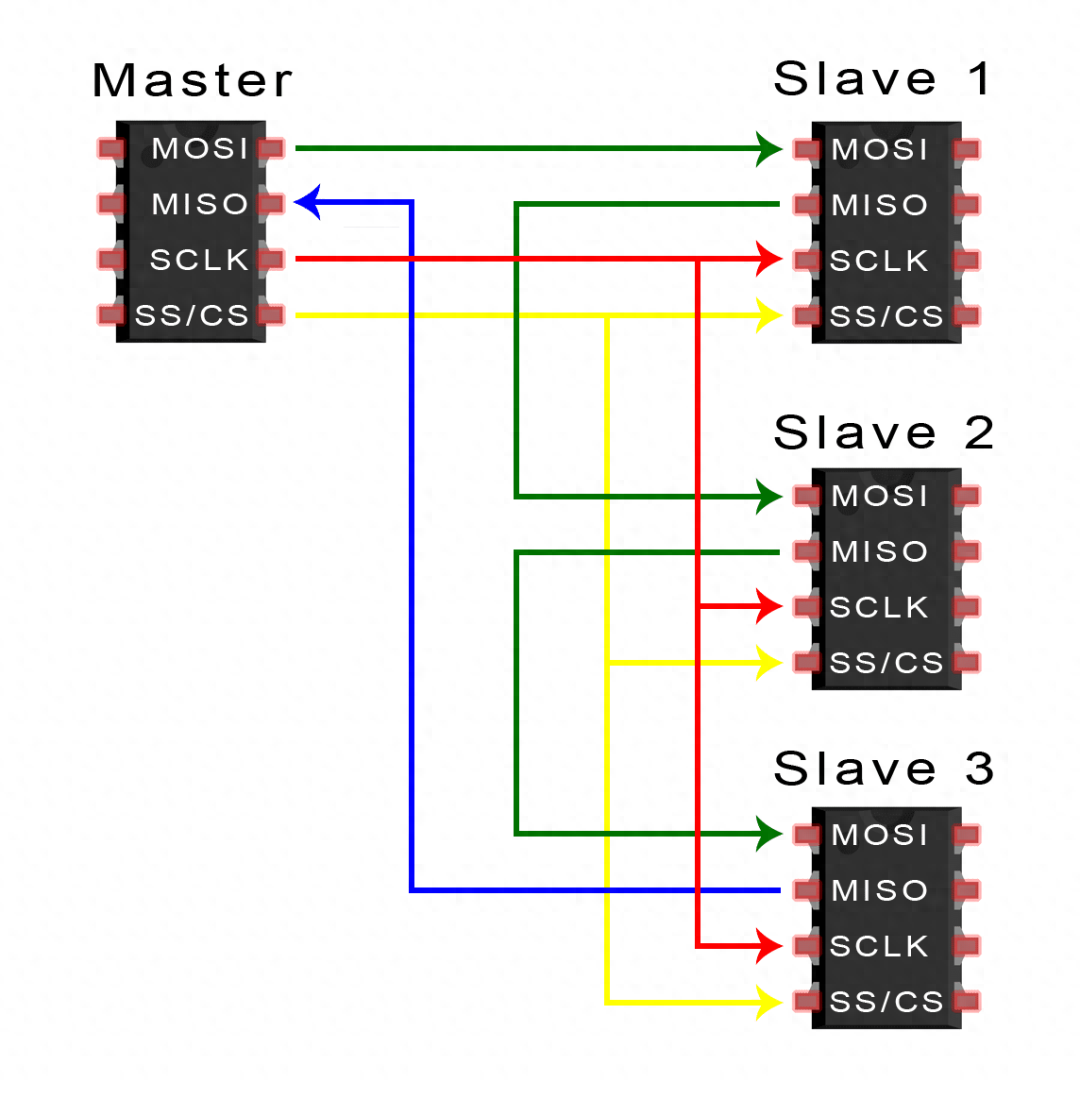
MOSI and MISO
The master sends data to the slave serially via MOSI, and the slave can also send data back to the master via MISO, allowing both to occur simultaneously. Thus, theoretically, SPI is a full-duplex communication protocol.
Transmission Steps
1. The master outputs the clock signal

2. The master pulls the SS/CS pin low to activate the slave

3. The master sends data to the slave via MOSI

4. If a response is needed, the slave returns data to the master via MISO

Using SPI has its advantages and disadvantages; when choosing between different communication protocols, careful consideration should be given based on project requirements.
Advantages and Disadvantages
Advantages
SPI communication has no start or stop bits, allowing data to flow continuously without interruption; it does not have a complex slave addressing system like I2C, and data transfer rates are higher than I2C (almost twice as fast). The separate MISO and MOSI lines allow simultaneous sending and receiving of data.
Disadvantages
SPI uses four lines (I2C and UART use two lines), lacks confirmation of successful signal reception (I2C has this feature), and has no form of error checking (like parity bits in UART).
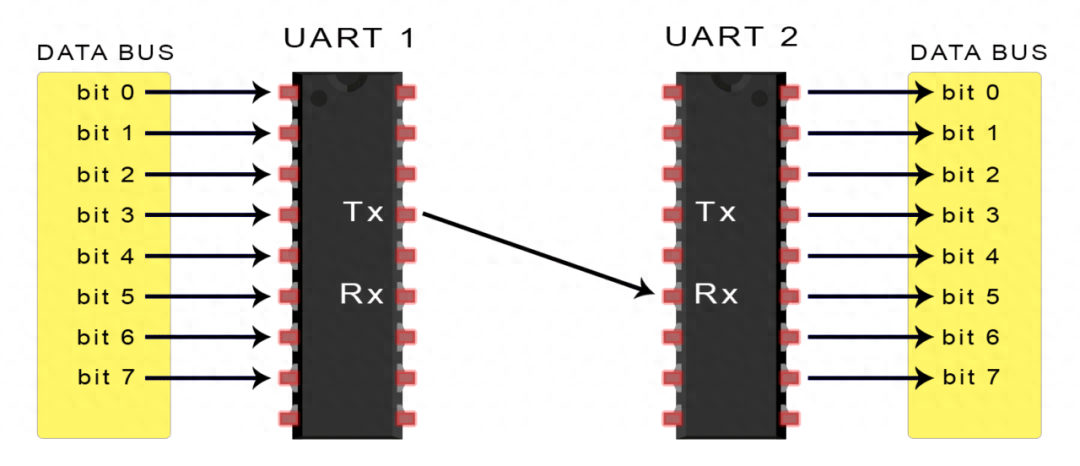
UART stands for Universal Asynchronous Receiver/Transmitter, also known as serial communication. Unlike communication protocols like SPI and I2C, it is a physical circuit or separate IC within the microcontroller. The primary purpose of UART is to send and receive serial data, and its best advantage is that it only uses two wires to transmit data between devices. The principles of UART are easy to understand, but if you haven’t read about the SPI communication protocol yet, it might be a good starting point.
UART Communication
In UART communication, two UARTs communicate directly with each other. The sending UART converts parallel data from a controlling device (like a CPU) into serial form and sends it to the receiving UART. Only two wires are needed to transmit data between two UARTs, with data flowing from the Tx pin of the sending UART to the Rx pin of the receiving UART:
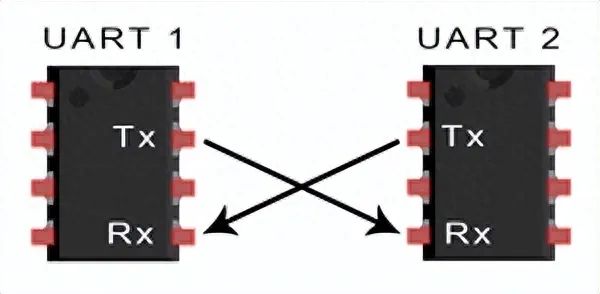
UART is an asynchronous communication, meaning there is no clock signal; instead, start and stop bits are added to the data packets. These bits define the start and end of the data packet, allowing the receiving UART to know when to read the data.
When the receiving UART detects the start bit, it reads the bits in the data frame at the frequency of the specified baud rate. The baud rate is a measure of the speed of data transmission, expressed in bits per second (bps). Both UARTs must operate at approximately the same baud rate, with a difference of only about 10% allowed between the sending and receiving UARTs.

Operating Principle
The sending UART, after obtaining parallel data from the data bus, adds a start bit, a parity bit, and a stop bit to form the data packet, which it serially outputs bit by bit from the Tx pin, while the receiving UART reads the data packet bit by bit on its Rx pin.
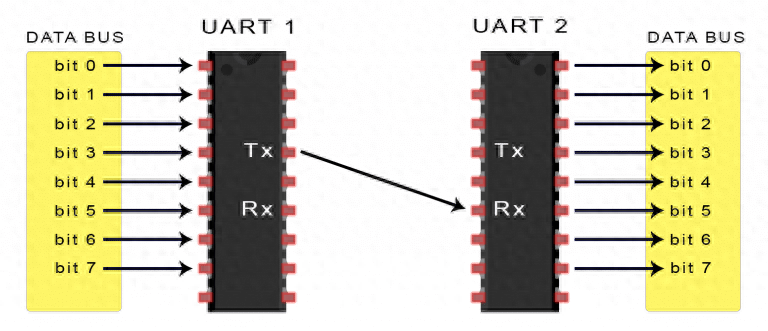
UART data includes 1 start bit, 5 to 9 data bits (depending on the UART), an optional parity bit, and 1 or 2 stop bits:
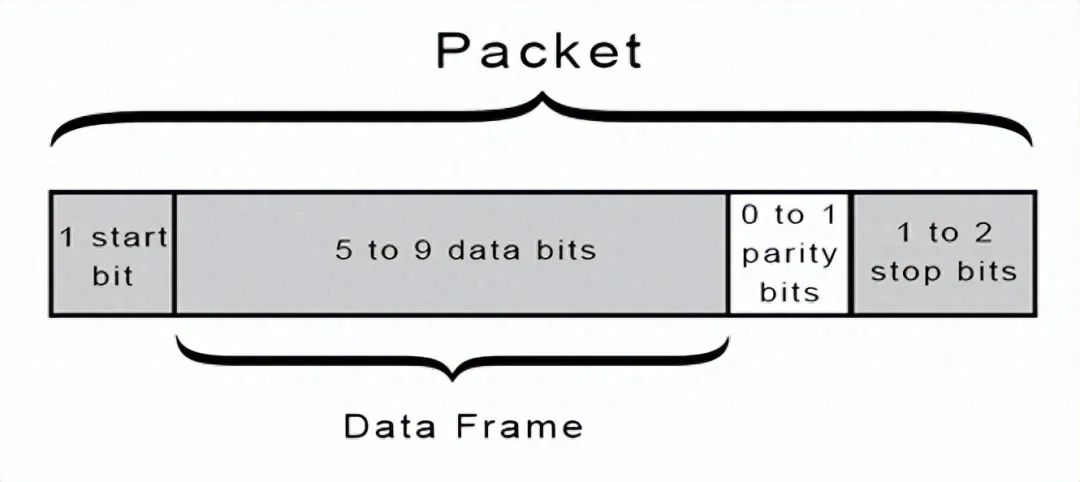
Start Bit:
UART data transmission lines typically remain at a high voltage level when not transmitting data. When transmission begins, the sending UART pulls the transmission line from high to low voltage within one clock cycle. When the receiving UART detects the transition from high voltage to low voltage, it begins reading the bits in the data frame at the baud rate frequency.
Data Frame:
The data frame contains the actual data being transmitted. If a parity bit is used, it can be 5 to 8 bits long. If no parity bit is used, the length of the data frame can be 9 bits.
Parity Bit:
The parity bit is how the receiving UART determines if there has been any data change during transmission. After reading the data frame, the receiving UART counts the number of bits that are 1 and checks whether the total is even or odd, and whether it matches the data.
Stop Bit:
To signal the end of the data packet, the sending UART drives the transmission line from low voltage to high voltage for at least two bit times.
Transmission Steps
-
The sending UART receives parallel data from the data bus:
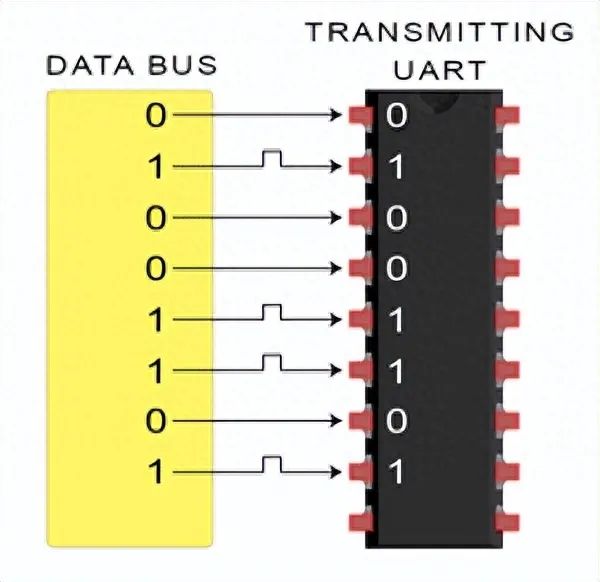
2. The sending UART adds the start bit, parity bit, and stop bit to the data frame:
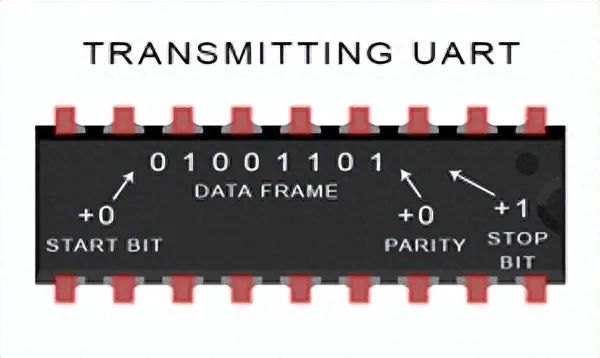
3. The entire data packet is serially sent from the sending UART to the receiving UART. The receiving UART samples the data line at the pre-configured baud rate:
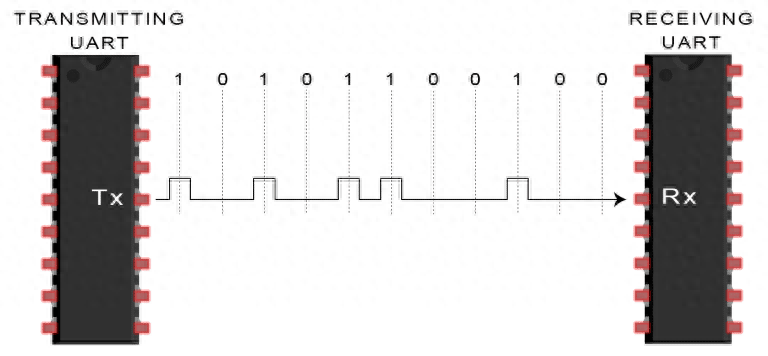
4. The receiving UART discards the start bit, parity bit, and stop bit from the data frame:
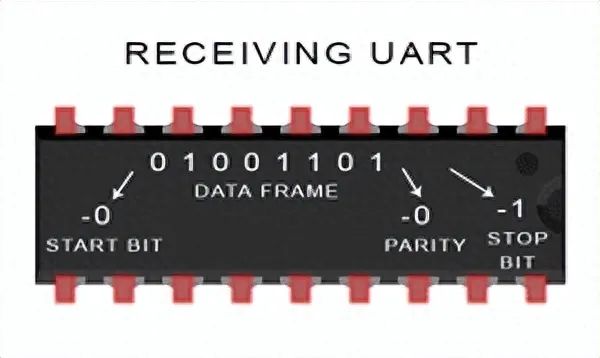
5. The receiving UART converts the serial data back into parallel data and transmits it to the receiving end’s data bus:
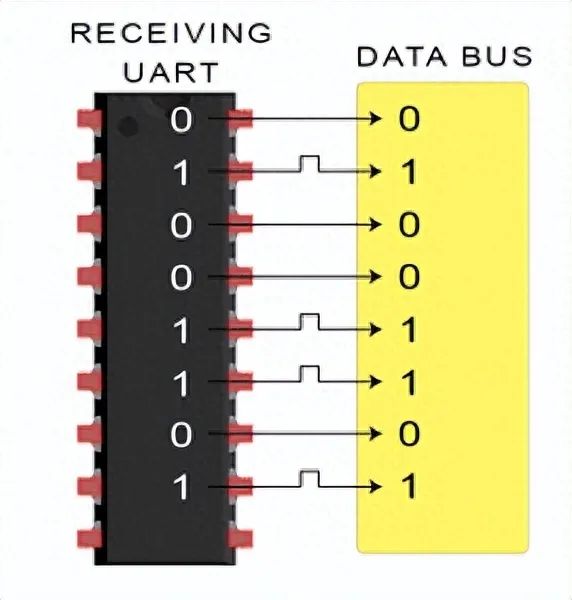
Advantages and Disadvantages
No communication protocol is perfect, but UART excels at its job. Here are some pros and cons to help you determine if they fit your project needs:
Advantages
-
Uses only two wires
-
No clock signal required
-
Includes parity bits for error checking
-
As long as both parties set up the packet structure
-
A well-documented and widely used method
Disadvantages
-
Maximum data frame size of 9 bits
-
Does not support multiple slave systems or multiple master systems
-
The baud rate of each UART must be within 10% of each other
I2C Communication
The I2C bus is a simple, bidirectional two-wire synchronous serial bus developed by Philips. It only requires two wires to transmit information. It combines the advantages of SPI and UART, allowing multiple slaves to connect to a single master (like SPI) while also enabling multiple masters to control one or more slaves. This is particularly useful when you want multiple microcontrollers to log data to a single storage card or display text on a single LCD.
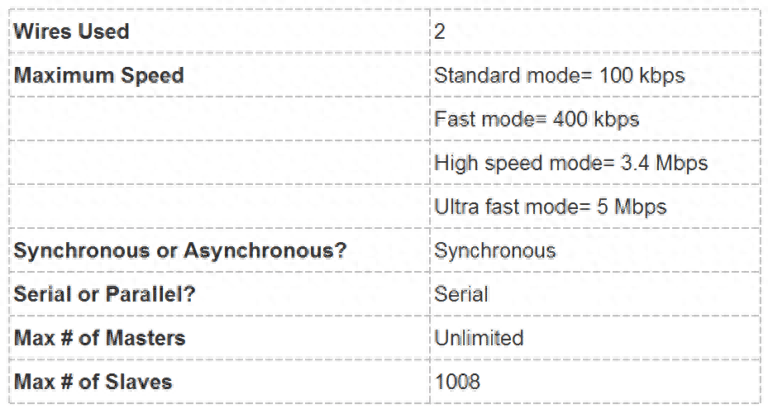
SDA (Serial Data) – data line.
SCL (Serial Clock) – clock line.
I2C is a serial communication protocol, so data is transmitted bit by bit along the SDA line. Like SPI, I2C also requires clock synchronization signals, and the clock is always controlled by the master.

Operating Principle
I2C data transmission occurs in the form of multiple msgs, each msg containing the binary address frame of the slave, one or more data frames, as well as start and stop conditions, read/write bits, and ACK/NACK bits between the data frames:

Start Condition: When SCL is high, SDA switches from high to low.
Stop Condition: When SCL is high, SDA switches from low to high.
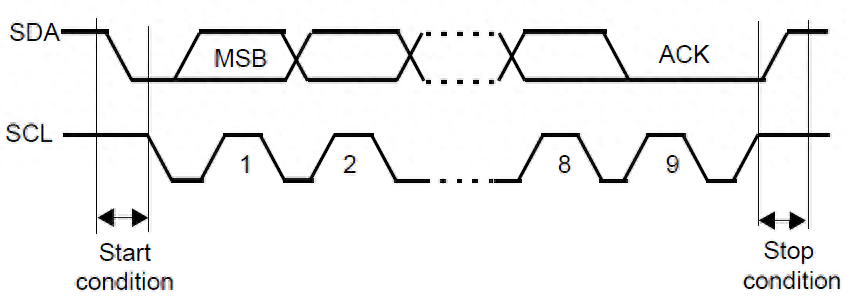
Address Frame: A unique 7-bit or 10-bit sequence for each slave device, used for address identification between master and slave devices.
Read/Write Bit: A bit that is low if the master is sending data to the slave and high if requesting data.
ACK/NACK: Each frame in the msg is followed by an ACK/NACK bit. If the address frame or data frame is successfully received, the receiving device returns an ACK bit to indicate confirmation.
Addressing
Since I2C does not have chip select lines like SPI, it requires another method to confirm a specific slave device, which is – addressing.
The master sends the address of the slave it wants to communicate with to each slave, and each slave compares it with its own address. If the address matches, it sends a low-level ACK bit back to the master. If it does not match, no action is taken, and the SDA line remains high.
Read/Write Bit
The end of the address frame contains a read/write bit. If the master is sending data to the slave, it is low. If the master is requesting data from the slave, it is high.
Data Frame
Once the master detects the ACK bit from the slave, it can send the first data frame. The data frame is always 8 bits long, followed by an ACK/NACK bit to verify the reception status. After all data frames are sent, the master can send a stop condition to terminate communication.
Transmission Steps
1. When the SCL line is high, the master starts bus communication by switching the SDA line from high to low.
2. The master sends the 7-bit or 10-bit address of the slave it wants to communicate with, along with the read/write bit:
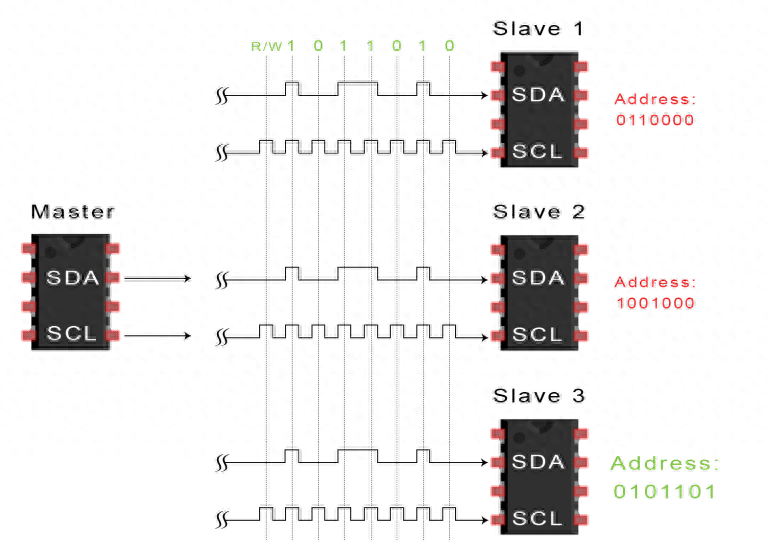
3. Each slave compares the address sent by the master with its own address. If the address matches, the slave returns an ACK bit by pulling the SDA line low. If the master’s address does not match the slave’s address, the slave pulls the SDA line high.
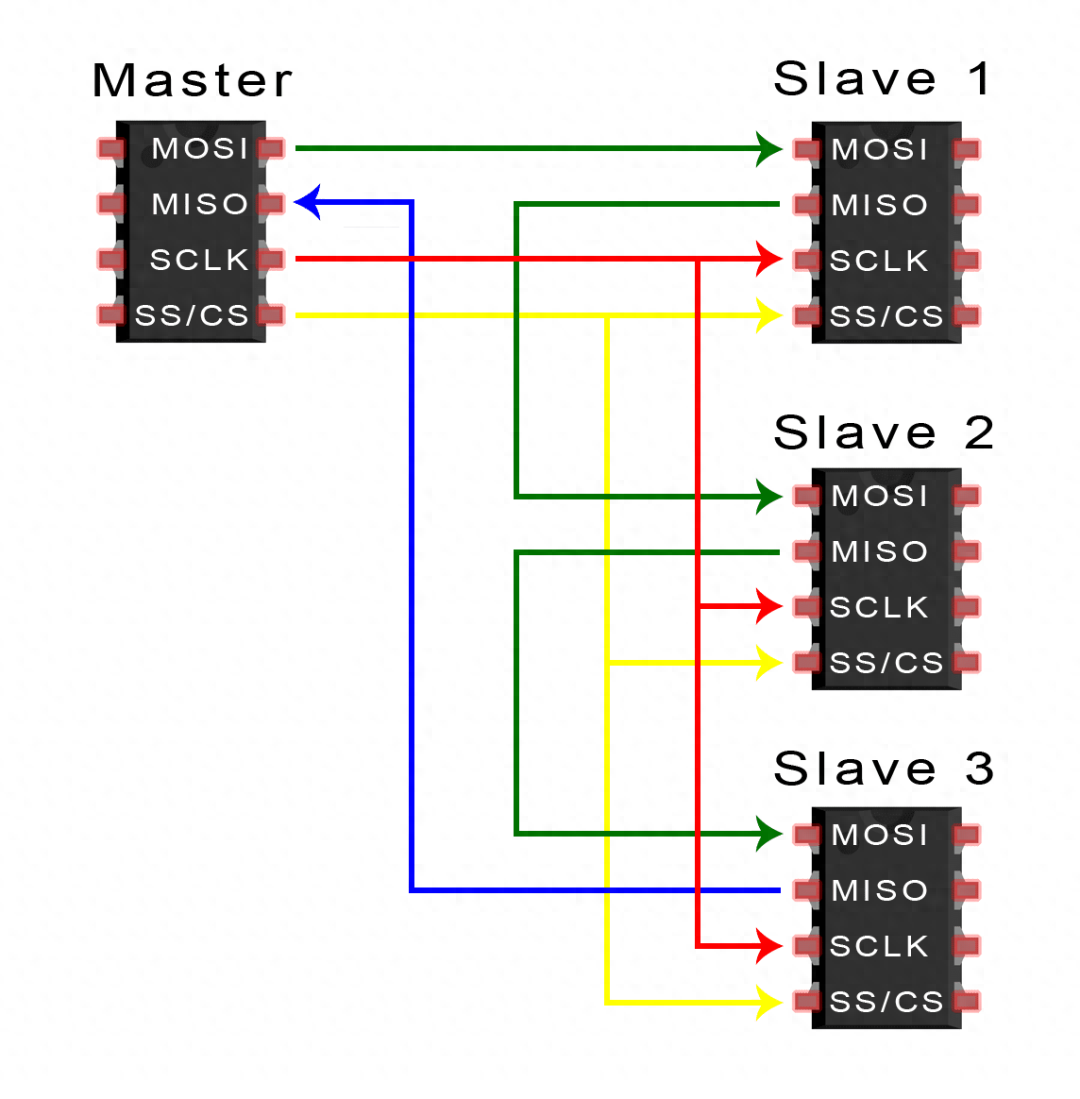
4. The master sends or receives data frames:
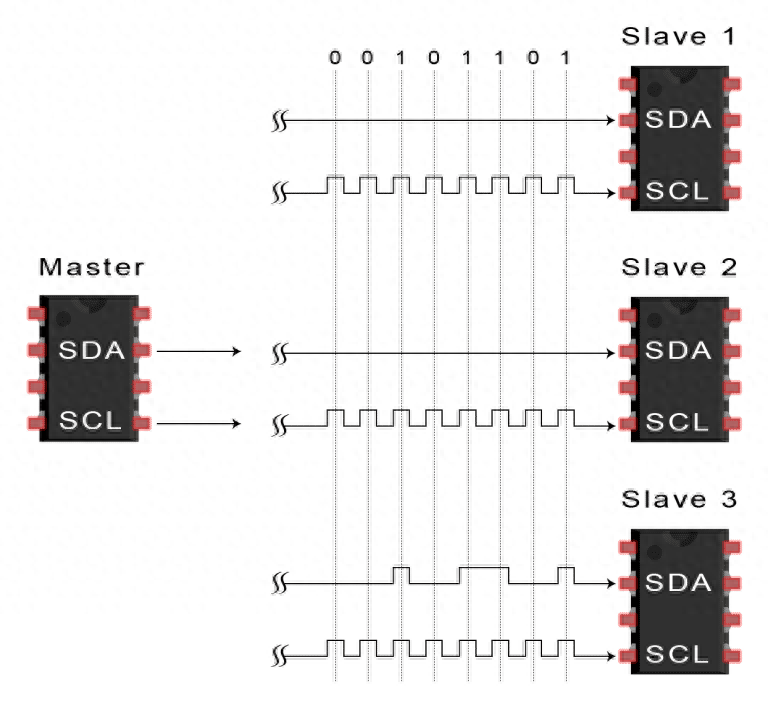
5. After each data frame transmission, the receiving device returns another ACK bit to the sender to confirm that the frame has been successfully received:
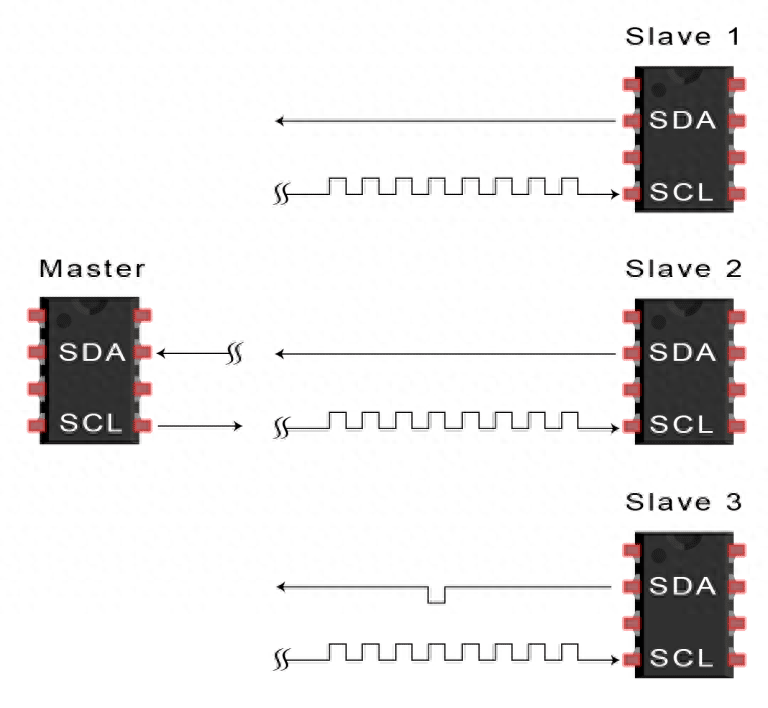
6. Subsequently, the master switches SCL to high and then switches SDA to high, sending the stop condition to the slave.
Single Master vs Multiple Slaves
Since I2C uses addressing, a single master can control multiple slaves. When using a 7-bit address, up to 128 (27) unique addresses can be used. Using a 10-bit address is uncommon but can provide 1,024 (210) unique addresses. To connect multiple slaves to a single master, use a 4.7K ohm pull-up resistor to connect them, for example, connecting the SDA and SCL lines to Vcc:
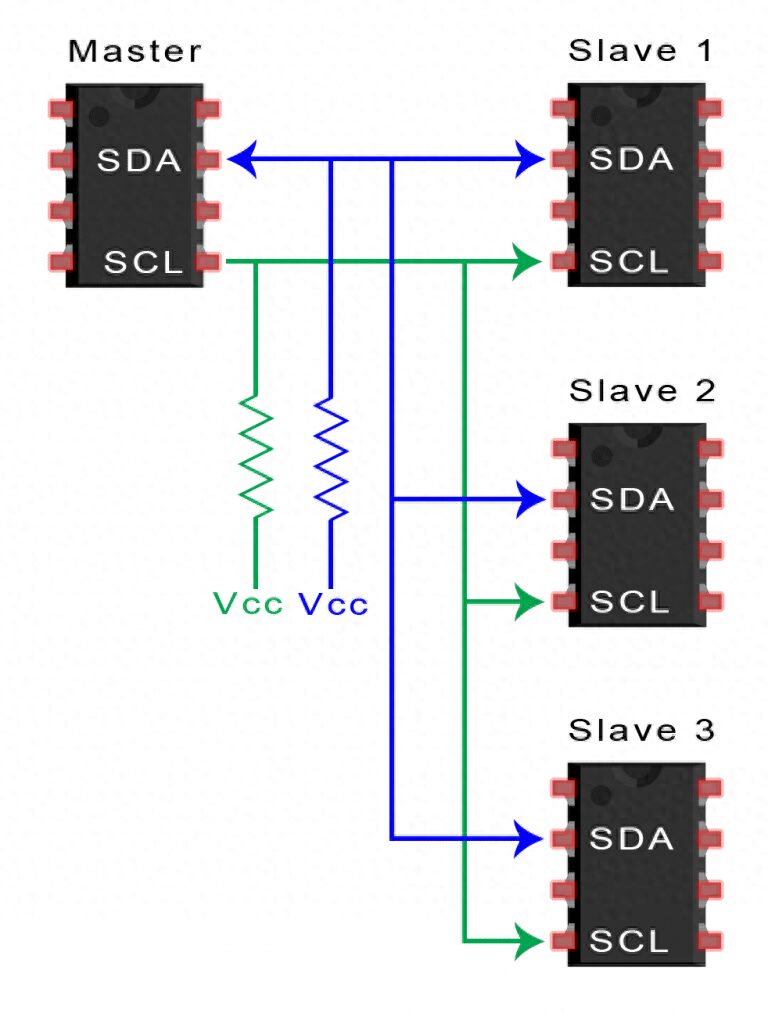
Multiple Masters vs Multiple Slaves
I2C supports multiple masters connected to multiple slaves. When two masters try to send or receive data simultaneously via the SDA line, issues can arise. Therefore, each master needs to check the SDA line before sending a message to see if it is low or high. If the SDA line is low, it means another master is controlling the bus. If the SDA line is high, it is safe to send data. When connecting multiple masters to multiple slaves, use a 4.7K ohm pull-up resistor to connect the SDA and SCL lines to Vcc:
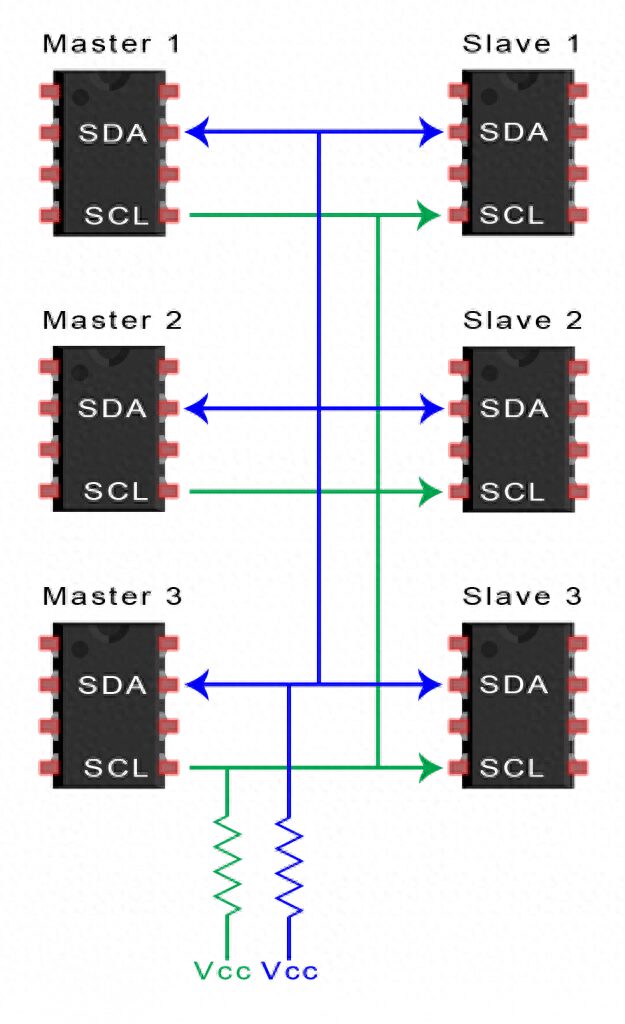
Advantages and Disadvantages
Compared to other protocols, I2C may sound complex. Here are some pros and cons to help you determine if they fit your project needs:
Advantages
-
Uses only two wires
-
Supports multiple masters and multiple slaves
-
Hardware is simpler than UART
-
A well-known and widely used protocol
Disadvantages
-
Data transfer rates are slower than SPI
-
Data frame size is limited to 8 bits
1. Linus once gave Windows 7 an enthusiastic thumbs up
2. Illustrated guide to understanding CPU cache
3. Differences and relationships between intranet, extranet, broadband, bandwidth, traffic, and internet speed